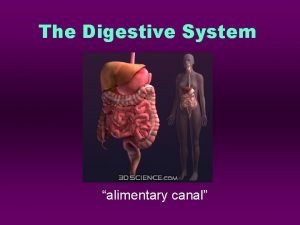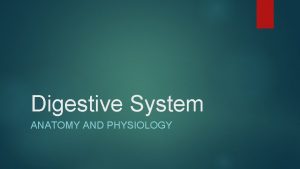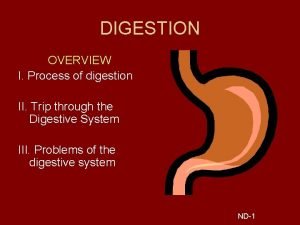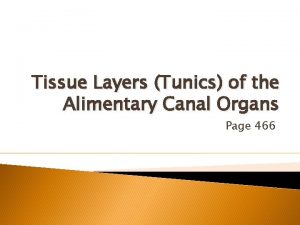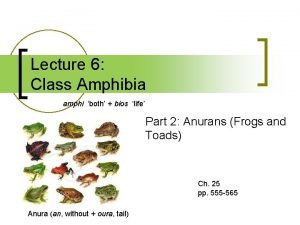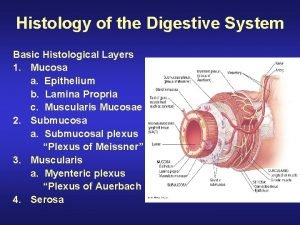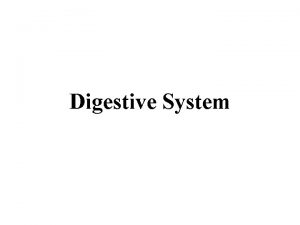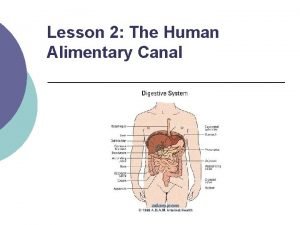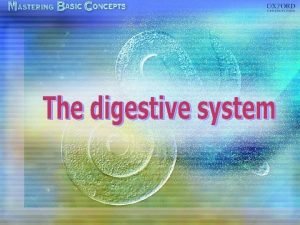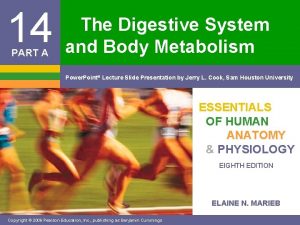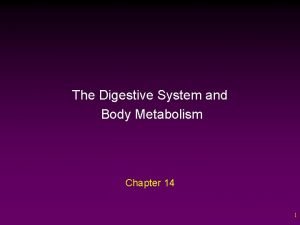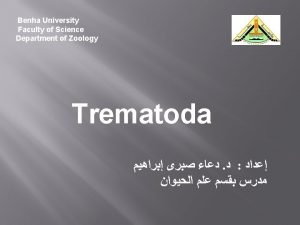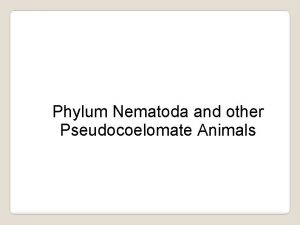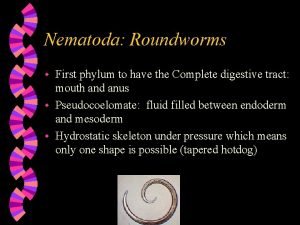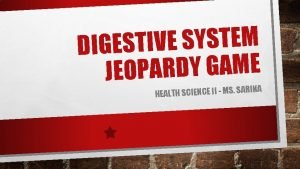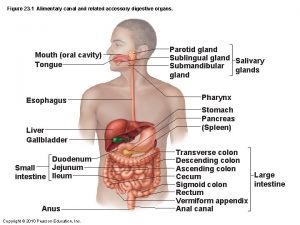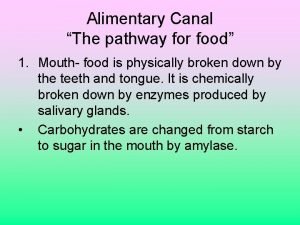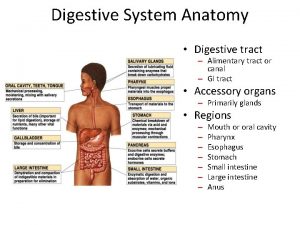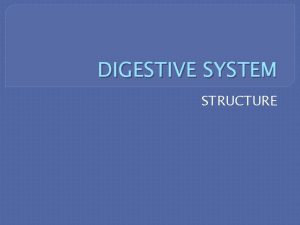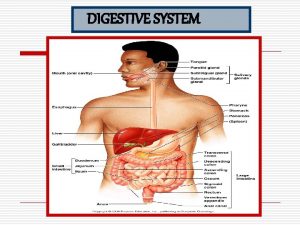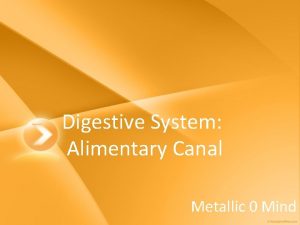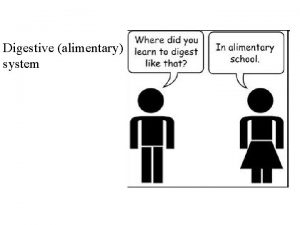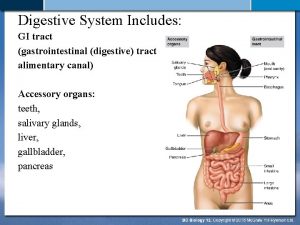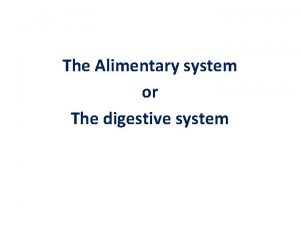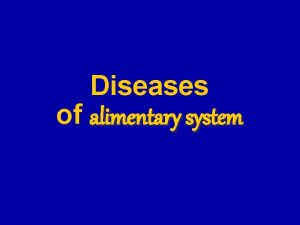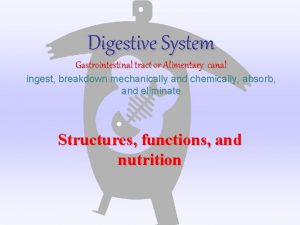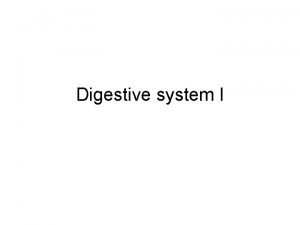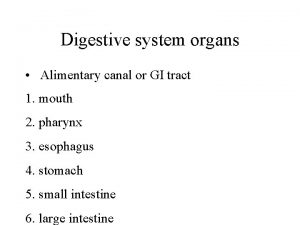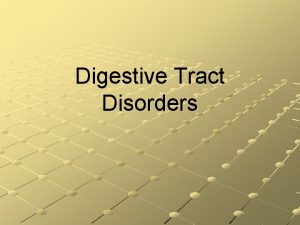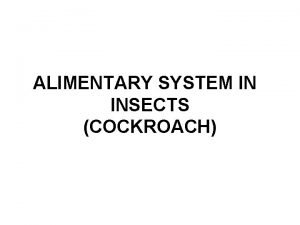The Digestive System The alimentary tract provides the





























- Slides: 29

The Digestive System

The alimentary tract provides the body with a continual supply of water, electrolytes, and nutrients. To achieve this requires (1) movement of food through the alimentary tract; (2) secretion of digestive juices and digestion of the food; (3) absorption of water, various electrolytes, and digestive products; (4) circulation of blood through the gastrointestinal organs to carry away the absorbed substances; and (5) control of all these functions by local, nervous, and hormonal systems.

�Introduction to the gastrointestinal system �The gastrointestinal tract (GIT) consists of a hollow muscular tube starting from the oral cavity, where food enters the mouth, continuing through the pharynx, oesophagus, stomach and intestines to the rectum and anus, where food is expelled. There are various accessory organs that assist the tract by secreting enzymes to help break down food into its component nutrients. Thus the salivary glands, liver, pancreas and gall bladder have important functions in the digestive system. Food is propelled along the length of the GIT by peristaltic movements of the muscular walls.


functions of the digestive system include: 1. Motility. This refers to the movement of food through the digestive tract through the processes of a. Ingestion: Taking food into the mouth. b. Mastication: Chewing the food and mixing it with saliva. c. Deglutition: Swallowing food. d. Peristalsis: Rhythmic, wavelike contractions that move food through the gastrointestinal tract.

2. Secretion. This includes both exocrine and endocrine secretions. a. Exocrine secretions: Water, hydrochloric acid, bicarbonate, and many digestive enzymes are secreted into the lumen of the gastrointestinal tract. The stomach alone, for example, secretes 2 to 3 liters of gastric juice a day. b. Endocrine secretions: The stomach and small intestine secrete a number of hormones that help to regulate the digestive system.

3. Digestion. This refers to the breakdown of food molecules into their smaller subunits, which can be absorbed. 4. Absorption. This refers to the passage of digested end products into the blood or lymph. 5. Storage and elimination. This refers to the temporary storage and subsequent elimination of indigestible food molecules.

Layers of the Gastrointestinal Tract The GI tract from the esophagus to the anal canal is composed of four layers, or tunics. Each tunic contains a dominant tissue type that performs specific functions in the digestive process. The four tunics of the GI tract, from the inside out, are the mucosa, submucosa, muscularis, and serosa


Mucosa The mucosa, which lines the lumen of the GI tract, is the absorptive and major secretory layer. It consists of a simple columnar epithelium supported by the lamina propria, a thin layer of areolar connective tissue containing numerous lymph nodules, which are important in protecting against disease External to the lamina propria is a thin layer of smooth muscle called the muscularis mucosae. This is the muscle layer responsible for the numerous small folds in certain portions of the GI tract. These folds greatly increase the absorptive surface area. Specialized goblet cells in the mucosa secrete mucus throughout most of the GI tract.

Submucosa The relatively thick , submucosa is a highly vascular layer of connective tissue that serves the mucosa. Absorbed molecules that pass through the columnar epithelial cells of the mucosa enter into blood and lymphatic vessels of the submucosa. In addition to blood vessels, the submucosa contains glands and nerve plexuses. The submucosal plexus (Meissner’s plexus) provides an autonomic nerve supply to the muscularis mucosae.


Muscularis The muscularis (also called the muscularis externa) is responsible for segmental contractions and peristaltic movement through the GI tract. The muscularis has an inner circular and an outer longitudinal layer of smooth muscle. Contractions of these layers move the food through the tract and physically pulverize and mix the food with digestive enzymes. The myenteric plexus (Auerbach’s plexus), located between the two muscle layers, provides the major nerve supply to the GI tract. It includes fibers and ganglia from both the sympathetic and parasympathetic divisions of the autonomic nervous system Serosa The outer serosa completes the wall of the GI tract. It is a binding and protective layer consisting of areolar connective tissue covered with a layer of simple squamous epithelium.

The effects of the sympathetic nerves reduce peristalsis and secretory activity and stimulate the contraction of sphincter muscles along the GI tract; therefore, they are antagonistic to the effects of parasympathetic nerve stimulation. The gut also contains the enteric nervous system, a discrete web of 100 million neurons that can control gut function without extrinsic control. It consists of the myenteric plexus, located between longitudinal and circular muscle layers, and the submucosal plexus. Reflexes mediate motility, secretions, hormone release, and vasculature.

components of the gastrointestinal system Oral cavity The oral cavity or mouth is responsible for the intake of food. Mastication refers to the mechanical breakdown of food by chewing and chopping actions of the teeth. The tongue, a strong muscular organ, manipulates the food bolus to come in contact with the teeth. It is also the sensing organ of the mouth for touch, temperature and taste using its specialised sensors known as papillae.

• Insalivation refers to the mixing of the oral cavity contents with salivary gland secretions. The mucin (a glycoprotein) in saliva acts as a lubricant. The oral cavity also plays a limited role in the digestion of carbohydrates. The enzyme serum amylase, a component of saliva, starts the process of digestion of complex carbohydrates. The final function of the oral cavity is absorption of small molecules such as glucose and water, across the mucosa. From the mouth, food passes through the pharynx and oesophagus via the action of swallowing.

Salivary glands Three pairs of salivary glands communicate with the oral cavity. Each is a complex gland with numerous acini lined by secretory epithelium. The acini secrete their contents into specialised ducts. Each gland is divided into smaller segments called lobes. Salivation occurs in response to the taste, smell or even appearance of food. This occurs due to nerve signals that tell the salivary glands to secrete saliva to prepare and moisten the mouth. Each pair of salivary glands secretes saliva with slightly different compositions


Parotids : The parotids produce a watery secretion which is also rich in proteins. Immunoglobins are secreted help to fight microorganisms and amylase proteins start to break down complex carbohydrates. Sublingual : They produce approximately 5% of the saliva and their secretions are very sticky due to the large concentration of mucin. The main functions are to provide buffers and lubrication. Submandibular : These glands produce a more viscid (thick) secretion, rich in mucin and with a smaller amount of protein. Mucin is a glycoprotein that acts as a lubricant

Esophagus The esophagus is that portion of the GI tract which connects the pharynx to the stomach. It is a muscular tube approximately 25 cm (10 in. ) long, located posterior to the trachea within the mediastinum of the thorax. the esophagus passes through the diaphragm by means of an opening called the esophageal hiatus. The esophagus is lined with a nonkeratinized stratified squamous epithelium; its walls contain either skeletal or smooth muscle, depending on the location. the middle third contains a mixture of skeletal and smooth muscle, and the terminal portion contains only smooth muscle

Swallowed food is pushed from the oral to the end of the esophagus by a wavelike muscular contraction called peristalsis the bolus along the digestive tract occurs because the circular smooth muscle contracts behind, and relaxes in front of, the bolus. This is followed by shortening of the tube by longitudinal muscle contraction. These contractions progress from the superior end of the esophagus to the astroesophageal junction at a rate of 2 to 4 cm per second as they empty the contents of the esophagus into the cardiac region of the stomach.

The stomach: • the stomach is a J shaped expanded bag, located just left of the midline between the oesophagus and small intestine. The stomach stores up to 2 liters of food • The functions of the stomach include: • The short-term storage of ingested food. • Mechanical breakdown of food by churning and mixing motions. • Chemical digestion of proteins by acids and enzymes. • Stomach acid kills germs. • Some absorption of substances such as alcohol. • Most of these functions are achieved by the secretion of stomach juices by gastric glands in the body and fundus. Some cells are responsible for secreting acid and others secrete enzymes to break down proteins.


gastric juice: thin, strongly acidic (p. H varying from 1 to 3), almost colorless liquid secreted by the glands in the lining of the stomach. Its essential constituents are the digestive enzymes pepsin , hydrochloric acid, and mucus. Pepsin converts proteins into simpler, more easily absorbed substances; it is aided in this by hydrochloric acid, which provides the acid environment in which pepsin is most effective. Gastric secretion is stimulated by a number of hormones and chemical substances, by the presence of food in the stomach, and by a number of psychological factors, such as the smell of a favorite food. Certain cells of the stomach lining secrete a substance known as intrinsic factor, which is necessary for the absorption of vitamin B 12; absence of this substance results in pernicious anemia, or B 12 deficiency

Cell types in the stomach that help with digestion There are four main types of cells for stomach secretions spread all over the inner surface of the stomach: Mucous cells secrete the alkaline mucous for shielding the epithelium from hydrochloric acid. These are found in the fundic, cardiac, and pyloric region. Parietal cells, located in the fundic, cardiac, and pyloric region, secrete hydrochloric acid; the acid activates release of pepsin for protein digestion. The acid also kills micro-organisms swallowed with the food. Chief cells secrete pepsin. These cells are located in the fundic region. G cells are found in the fundic, pyloric, and gastric region. These secrete gastrin which stimulates the secretion of hydrochloric acid.


Motor Functions of the Stomach The motor functions of the stomach are threefold: (1) storage of large quantities of food until the food can be processed in the stomach, duodenum, and lower intestinal tract; (2) mixing of this food with gastric secretions until it forms a semifluid mixture called chyme; and (3) slow emptying of the chyme from the stomach into the small intestine at a rate suitable for proper digestion and absorption by the small intestine. Figure 63– 2 shows the basic anatomy of the stomach. Anatomically, the stomach is usually divided into two major parts: (1) the body and (2) the antrum. Physiologically, it is more appropriately divided into (1) the “orad” portion, comprising about the first two thirds of the body, and (2) the “caudad” portion, comprising the remainder of the body plus the antrum.

Storage Function of the Stomach As food enters the stomach, it forms concentric circles of the food in the orad portion of the stomach, the newest food lying closest to the esophageal opening and the oldest food lying nearest the outer wall of the stomach. Normally, when food stretches the stomach, a “vagovagal reflex” from the stomach to the brain stem and then back to the stomach reduces the tone in the muscular wall of the body of the stomach so that the wall bulges progressively outward, accommodating greater and greater quantities of food up to a limit in the completely relaxed stomach of 0. 8 to 1. 5 liters. The pressure in the stomach remains low until this limit is approached.

 Alimentary tract and metabolism
Alimentary tract and metabolism Pyramidal vs extrapyramidal
Pyramidal vs extrapyramidal Anterior spinothalamic tract
Anterior spinothalamic tract What does the inside of a human stomach look like
What does the inside of a human stomach look like Phylum cnidaria characteristics
Phylum cnidaria characteristics 13.2 structures of the digestive system
13.2 structures of the digestive system Circulatory system interactions with other systems
Circulatory system interactions with other systems End of digestive tract
End of digestive tract Alimentary canal tunics
Alimentary canal tunics Order anura characteristics
Order anura characteristics Histology digestive system
Histology digestive system General structure of digestive tract
General structure of digestive tract Digestive system histology
Digestive system histology Digestive system circulatory system and respiratory system
Digestive system circulatory system and respiratory system Pic of human digestive system
Pic of human digestive system Nervous system and digestive system
Nervous system and digestive system Alimentary canal diagram
Alimentary canal diagram Earthworm phylum
Earthworm phylum Introduction about
Introduction about Structure of alimentary canal
Structure of alimentary canal Alimentary canal of mammals
Alimentary canal of mammals Which is not part of the alimentary canal
Which is not part of the alimentary canal Figure 14-1 digestive system
Figure 14-1 digestive system Flatworm subkingdom
Flatworm subkingdom Phylum nematoda anatomy
Phylum nematoda anatomy First phylum with complete digestive system
First phylum with complete digestive system What organ is responsible for drying out indigestible food
What organ is responsible for drying out indigestible food Alimentary canal
Alimentary canal Alimentary canal pathway
Alimentary canal pathway Alimentary canal
Alimentary canal



